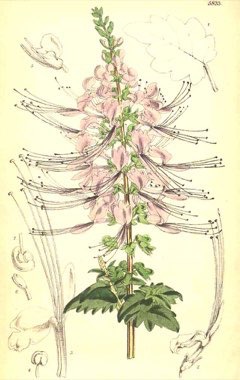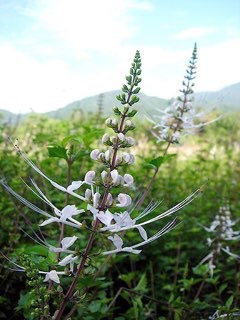 |
|
http://www.edibleplants.org |
 |
| Wizan wikimedia.org |
Translate this page:
Summary
Orthosiphon aristatus, commonly known as Java Tea or Cat's Whiskers, is a popular herbal plant grown in East Asia. It reaches a height of 200 cm upon maturity. The leaves contain flavones, saponins, a glycoside, an essential oil, and potassium. It has anti-microbial and anti-inflammatory properties. It is highly diuretic and used in the treatment of various kidney conditions, cystitis, urethritis, and gout. It has two named varieties - Orthosiphon aristatus var. aristatus and Orthosiphon aristatus var. velteri. Plant propagation is through seeds and stem cuttings.
Physical Characteristics

 Orthosiphon aristatus is a PERENNIAL growing to 1 m (3ft 3in) by 0.5 m (1ft 8in) at a fast rate.
Orthosiphon aristatus is a PERENNIAL growing to 1 m (3ft 3in) by 0.5 m (1ft 8in) at a fast rate.
See above for USDA hardiness. It is hardy to UK zone 10.
Suitable for: light (sandy), medium (loamy) and heavy (clay) soils and prefers well-drained soil. Suitable pH: neutral and basic (mildly alkaline) soils. It can grow in full shade (deep woodland) semi-shade (light woodland) or no shade. It prefers moist soil.
UK Hardiness Map
US Hardiness Map
Synonyms
Clerodendranthus spicatus (Thunb.) C.Y.Wu Clerodendranthus stamineus (Benth.) Kud? Clerodendrum spic
Plant Habitats
Edible Uses
References More on Edible Uses
Medicinal Uses
Plants For A Future can not take any responsibility for any adverse effects from the use of plants. Always seek advice from a professional before using a plant medicinally.
Antibacterial Antibiotic Antifungal Antiinflammatory Antirheumatic Diuretic Emetic Hypoglycaemic
Kidney
Java tea is a popular herbal remedy in southeast Asia and is also commonly exported to Germany and various other countries. Research has confirmed the presence of a number of medically active compounds and also the diuretic action of the leaves[310 ]. The leaves contain flavones (including sinensetin), saponins, a glycoside (orthosiphonin), an essential oil and large amounts of potassium (which is largely responsible for the diuretic effect)[254 , 310 ]. In tests with healthy volunteers in Thailand, extracts of the plant increased excretion of citrate and oxalate. Although a higher level of oxalate may increase the risk of kidney stones, the increased citrate output helps prevent stone formation[310 ]. It has been demonstrated that Java tea has anti-microbial properties. Aqueous extracts markedly inhibited the growth of both gram-positive and gram-negative bacteria[310 ]. Saponins may play a role in bacteriostatic activity in vitro[310 ]. Caffeic acid derivatives (which represent as much as 95% of the phenolic substances present in a hot water extract) may also be responsible for the antibiotic activity[310 ]. The lipophilic flavonoids, of which sinensetin and tetramethylscutellarein are the most abundant, have shown inhibitory effect against Ehrlich ascites tumour cells in vitro[310 ]. Additionally, these flavonoids may be partially responsible for anti-inflammatory effects, since flavonoids are inhibitors of cyclo-oxygenase and lipoxygenase[310 ]. The crude herb is said to cause vomiting[310 ]. The leaves are strongly diuretic and are believed to increase the kidneys' ability to eliminate nitrogen-containing compounds[254 ]. They are used in the treatment of kidney infections, kidney stones and poor renal function as a result of chronic nephritis[254 , 348 ]. They are also used in the treatment of cystitis, urethritis and gout[254 , 310 ]. They are used, in combination with other plants such as Sonchus spp or Barleria spp, to stimulate the kidneys and as a medicine for nephritis, gallstones and diabetes[310 ]. Combined with the leaves of Blumea balsamifera and Phyllanthus fraternus, plus the rhizomes of Curcuma xanthorrhiza, the leaves are used to treat jaundice[310 ]. Combined with the leaves of Andrographis paniculata, they are used to treat diabetes[310 ]. In mixtures with the leaves of other plants, they are also used against gout, rheumatism and arteriosclerosis[310 ].
References More on Medicinal Uses
The Bookshop: Edible Plant Books
Our Latest books on Perennial Plants For Food Forests and Permaculture Gardens in paperback or digital formats.

Edible Tropical Plants
Food Forest Plants for Hotter Conditions: 250+ Plants For Tropical Food Forests & Permaculture Gardens.
More

Edible Temperate Plants
Plants for Your Food Forest: 500 Plants for Temperate Food Forests & Permaculture Gardens.
More

More Books
PFAF have eight books available in paperback and digital formats. Browse the shop for more information.
Shop Now
Other Uses
References More on Other Uses
Cultivation details
The plant has escaped from cultivation and become naturalised in some areas[305 ]. Harvest usually starts 8 - 10 weeks after planting, at the beginning of flowering. Every 2 - 3 weeks the upper 4 - 10 leaves of shoots are plucked by hand[310 ]. Annual yields of dry leaves amount to 1,500 kg/ha[310 ]. Smallholders usually sun-dry leaves. In estate farming artificial drying is practised. To obtain a high-quality product, the leaves are first withered in the air, and then dried at 45 - 50°c. Dried leaves of good quality are green (a blackish colour is due to overheating or contact with metal containers), have a good aroma, a moisture content below 14%, a bitter taste, an ash content of about 10%, a contamination content of less than 2%, and do not contain insects or fungi[310 ]. Three cultivars of Orthosiphon aristatus are distinguished: one with bluish-violet and two with white flowers. The white-flowered cultivar with reddish stems, petioles and leaf veins appears to possess the best diuretic qualities[310 ]. Flowering Time: Late Summer/Early Fall. Bloom Color: Light Blue Violet/Lavender White/Near White. Spacing: 9-12 in. (22-30 cm).
References Carbon Farming Information and Carbon Sequestration Information
Temperature Converter
Type a value in the Celsius field to convert the value to Fahrenheit:
Fahrenheit:
The PFAF Bookshop
Plants For A Future have a number of books available in paperback and digital form. Book titles include Edible Plants, Edible Perennials, Edible Trees,Edible Shrubs, Woodland Gardening, and Temperate Food Forest Plants. Our new book is Food Forest Plants For Hotter Conditions (Tropical and Sub-Tropical).
Shop Now
Plant Propagation
Seed - Stem cuttings, 15 - 20cm long, which have some buds[310 ]. Cuttings are usually planted in shade, with 40 - 60cm between plants and rows. Often 4 - 6 cuttings are placed in one hole. Direct planting in the field or in the backyard, as is most common, can be done all the year round, but the usual time of planting is at the beginning of the rainy season. For plantations, planting in a nursery for a period of 45 days with the cuttings placed vertically with only one bud visible is preferred[310 ].
Other Names
If available other names are mentioned here
Java Tea, Cat's Whiskers, cat's whiskers, cat's-whiskers, cat´s whiskers|un known , folia orthosiphonis staminei, java tea, java-tea, katzenbart, kidney tea plant, koemis koetjing, kumis kucing, kumis kutjing, long-stamened orthosiphon, misai kucing, morrhårsmynta, moustache de chat, orthosiphon, orthosiphonblätter, orthosiphonis folium, orthosipnonis stamini folium, shen cha, thé de java, thé du java, tè de giava, whiskerplant.
Native Range
TEMPERATE ASIA: China (Fujian Sheng, Guangxi Zhuangzu Zizhiqu, Hainan Sheng, Yunnan Sheng), Taiwan TROPICAL ASIA: Papua New Guinea, Cambodia, Laos, Myanmar, Thailand, Vietnam, Indonesia, Malaysia, Philippines AUSTRALASIA: Australia (Queensland (north))
Weed Potential
Right plant wrong place. We are currently updating this section.
Please note that a plant may be invasive in one area but may not in your area so it's worth checking.
Conservation Status
IUCN Red List of Threatened Plants Status : This taxon has not yet been assessed

Growth: S = slow M = medium F = fast. Soil: L = light (sandy) M = medium H = heavy (clay). pH: A = acid N = neutral B = basic (alkaline). Shade: F = full shade S = semi-shade N = no shade. Moisture: D = dry M = Moist We = wet Wa = water.
Now available:
Food Forest Plants for Mediterranean Conditions
350+ Perennial Plants For Mediterranean and Drier Food Forests and Permaculture Gardens.
[Paperback and eBook]
This is the third in Plants For A Future's series of plant guides for food forests tailored to
specific climate zones. Following volumes on temperate and tropical ecosystems, this book focuses
on species suited to Mediterranean conditions—regions with hot, dry summers and cool, wet winters,
often facing the added challenge of climate change.
Read More
Expert comment
Author
(Blume) Miq.
Botanical References
Links / References
For a list of references used on this page please go here
A special thanks to Ken Fern for some of the information used on this page.
Readers comment
| Add a comment |
|
If you have important information about this plant that may help other users please add a comment or link below. Only comments or links that are felt to be directly relevant to a plant will be included. If you think a comment/link or information contained on this page is inaccurate or misleading we would welcome your feedback at [email protected]. If you have questions about a plant please use the Forum on this website as we do not have the resources to answer questions ourselves.
* Please note: the comments by website users are not necessarily those held by PFAF and may give misleading or inaccurate information.
To leave a comment please Register or login here All comments need to be approved so will not appear immediately.
|
Subject : Orthosiphon aristatus
|
|
|
|